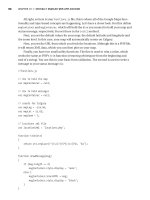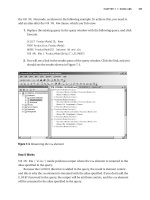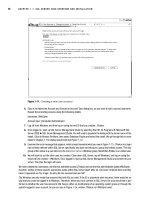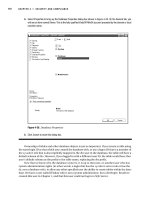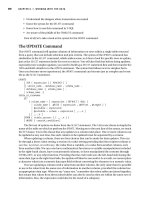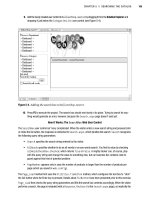Beginning Java SE 6 Platform From Novice to Professional phần 4 pps
Bạn đang xem bản rút gọn của tài liệu. Xem và tải ngay bản đầy đủ của tài liệu tại đây (451.13 KB, 51 trang )
• Its abstract javax.swing.DefaultRowSorter<M, I> subclass, which supports sorting
and filtering around a grid-based data model
• The
DefaultRowSorter<M, I>’s javax.swing.table.TableRowSorter<M extends
TableModel> subclass, which provides table component sorting and filtering
via a
javax.swing.table.TableModel
It is easy to introduce sorting to a table component. After creating the table’s
model and initializing the table component with this model, pass the model to
TableRowSorter<M extends TableModel>’s constructor. Then pass the resulting RowSorter<M>
to JTable’s public void setRowSorter(RowSorter<? extends TableModel> sorter) method:
TableModel model =
JTable table = new JTable (model);
RowSorter<TableModel> sorter = new TableRowSorter<TableModel> (model);
table.setRowSorter (sorter);
To demonstrate how easy it is to add sorting to your tables, I have designed a simple
application that itemizes some grocery items and their prices in a two-column table.
Listing 4-3 presents the source code.
Listing 4-3. PriceList1.java
// PriceList1.java
import javax.swing.*;
import javax.swing.table.*;
public class PriceList1 extends JFrame
{
public PriceList1 (String title)
{
super (title);
setDefaultCloseOperation (EXIT_ON_CLOSE);
String [] columns = { "Item", "Price" };
Object [][] rows =
{
{ "Bag of potatoes", 10.98 },
{ "Magazine", 7.99 },
CHAPTER 4 ■ GUI TOOLKITS: SWING130
830-X CH04.qxd 8/30/07 6:52 PM Page 130
{ "Can of soup", 0.89 },
{ "DVD movie", 39.99 }
};
TableModel model = new DefaultTableModel (rows, columns);
JTable table = new JTable (model);
RowSorter<TableModel> sorter = new TableRowSorter<TableModel> (model);
table.setRowSorter (sorter);
getContentPane ().add (new JScrollPane (table));
setSize (200, 150);
setVisible (true);
}
public static void main (String [] args)
{
Runnable r = new Runnable ()
{
public void run ()
{
new PriceList1 ("Price List #1");
}
};
java.awt.EventQueue.invokeLater (r);
}
}
Run this application, and you will see output similar to the table shown in Figure 4-3.
Figure 4-3. Unsorted table
Click the Item column’s header, and the rows will sort in ascending order of this
column’s values. A small up triangle will appear beside the column name to identify
the current sort direction, as shown in Figure 4-4.
CHAPTER 4 ■ GUI TOOLKITS: SWING 131
830-X CH04.qxd 8/30/07 6:52 PM Page 131
Figure 4-4. Sorted table based on the Item column
Suppose that you decide to sort the items in ascending order of price (smallest price
item first). After clicking the Price column’s header, a small up triangle appears beside
the column name. However, as Figure 4-5 indicates, the sort result is unexpected.
Figure 4-5. Prices are sorted based on string comparisons.
The prices are not sorted based on their numerical values. If they were, the row con-
taining DVD movie and 39.99 would be the last row in the table. Instead, rows have been
sorted based on the string representations of the price values.
According to the JDK documentation for the
TableRowSorter<M extends TableModel>
class, java.util.Comparator<T> comparators are used to compare objects during a sort.
The
Comparator<T> comparator that is chosen is based on five rules, which I have
excerpted (with minor additions) from the documentation (in the top-down order in
which the decision is made):
• If a
Comparator<T> has been specified for the column by the setComparator method,
use it.
• If the column class as returned by
getColumnClass is String, use the Comparator<T>
returned by Collator.getInstance().
• If the column class implements
Comparable<T>, use a Comparator<T> that invokes the
compareTo method.
CHAPTER 4 ■ GUI TOOLKITS: SWING132
830-X CH04.qxd 8/30/07 6:52 PM Page 132
•If a javax.swing.table.TableStringConverter has been specified, use it to convert the
values to
Strings and then use the Comparator<T> returned by Collator.getInstance().
• Otherwise, use the
Comparator<T> returned by Collator.getInstance() on the
results from calling
toString on the objects.
If you explicitly attach a
Comparator<T> to a column via public void
setComparator(int column, Comparator<?> comparator), this Comparator<T> will
be used during the sort (as indicated by the first rule). In contrast, it is easier to
subclass
javax.swing.table.DefaultTableModel and override the public Class
getColumnClass(int column) method, which is what Listing 4-4 accomplishes.
Listing 4-4. PriceList2.java
// PriceList2.java
import javax.swing.*;
import javax.swing.table.*;
public class PriceList2 extends JFrame
{
public PriceList2 (String title)
{
super (title);
setDefaultCloseOperation (EXIT_ON_CLOSE);
String [] columns = { "Item", "Price" };
Object [][] rows =
{
{ "Bag of potatoes", 10.98 },
{ "Magazine", 7.99 },
{ "Can of soup", 0.89 },
{ "DVD movie", 39.99 }
};
TableModel model = new DefaultTableModel (rows, columns)
{
public Class getColumnClass (int column)
{
if (column >= 0 &&
CHAPTER 4 ■ GUI TOOLKITS: SWING 133
830-X CH04.qxd 8/30/07 6:52 PM Page 133
column <= getColumnCount ())
return getValueAt (0, column).getClass ();
else
return Object.class;
}
};
JTable table = new JTable (model);
RowSorter<TableModel> sorter = new TableRowSorter<TableModel> (model);
table.setRowSorter (sorter);
getContentPane ().add (new JScrollPane (table));
setSize (200, 150);
setVisible (true);
}
public static void main (String [] args)
{
Runnable r = new Runnable ()
{
public void run ()
{
new PriceList2 ("Price List #2");
}
};
java.awt.EventQueue.invokeLater (r);
}
}
DefaultTableModel
always returns Object.class from its getColumnClass() method.
According to the fifth rule, this results in the
toString() method being called during
sorting (and the result shown previously in Figure 4-5). By overriding
getColumnClass()
and having the overridden method return the appropriate type, sorting takes advantage
of the returned
Class object’s Comparable<T> (if there is one), according to the third rule.
Figure 4-6 shows the properly sorted price list.
CHAPTER 4 ■ GUI TOOLKITS: SWING134
830-X CH04.qxd 8/30/07 6:52 PM Page 134
Figure 4-6. The DVD movie item is now displayed in the last row, where it should be based
on its price.
■Tip JTable’s public void setAutoCreateRowSorter(boolean autoCreateRowSorter) method
offers the simplest way to attach a row sorter to a table component. For more information about this
method, check out “Mustang (Java SE 6) Gallops into Town” (
/>article.asp?p=661371&rl=1).
Filtering the Table’s Rows
The DefaultRowSorter<M, I> class provides a public void setRowFilter(RowFilter<? super
M,? super I> filter) method for installing a filter that lets you determine which rows are
displayed and which rows are hidden. You can pass to
filter an instance of one of the
filters returned from the static methods in the abstract
javax.swing.RowFilter<M, I> class,
or pass
null to remove any installed filter and allow all rows to be displayed. Table 4-2
shows
RowFilter’s filter factory methods.
Table 4-2. RowFilter Filter Factory Methods
Method Description
public static <M,I> RowFilter<M,I> Returns a row filter that includes a row if all
andFilter(Iterable<? extends RowFilter<? of the specified row filters include the row.
super M,? super I>> filters)
public static <M,I> RowFilter<M,I> Returns a row filter that includes only those rows
dateFilter(RowFilter.ComparisonType that have at least one java.util.Date value in
type, Date date, int indices) the indices columns that meets the criteria
specified by type. If the indices argument is not
specified, all columns are checked.
public static <M,I> RowFilter<M,I> Returns a row filter that includes a row if the
notFilter(RowFilter<M,I> filter) specified row filter does not include the row.
public static <M,I> RowFilter<M,I> Returns a row filter that includes only those rows
numberFilter(RowFilter.ComparisonType type, that have at least one Number value in the
Number number, int indices) indices columns that meets the criteria
specified by type. If the indices argument is
not specified, all columns are checked.
CHAPTER 4 ■ GUI TOOLKITS: SWING 135
Continued
830-X CH04.qxd 8/30/07 6:52 PM Page 135
public static <M,I> RowFilter<M,I> Returns a row filter that includes a row if any of
orFilter(Iterable<? extends the specified row filters include the row.
RowFilter<? super M,? super I>> filters)
public static <M,I> RowFilter<M,I> Returns a row filter that uses a regular expression
regexFilter(String regex, int indices) to determine which rows to include. Each
column identified by indices is checked. The
row is returned if one of the column values
matches the regex. If the indices argument is
not specified, all columns are checked.
Row filtering is useful in the context of a database application. Rather than submit
a potentially expensive SQL
SELECT statement to the database management system to
retrieve a subset of a table’s rows based on some criteria, filtering rows via a table compo-
nent and its row filter is bound to be much faster. For example, suppose your table
component presents a log of bugs (bug identifier, description, date filed, and dated fixed)
found while testing software. Furthermore, suppose that you want to present only those
rows whose description matches some entered regular expression. Listing 4-5 presents an
application that accomplishes this task.
Listing 4-5. BugLog.java
// BugLog.java
import java.awt.*;
import java.awt.event.*;
import java.text.*;
import java.util.*;
import javax.swing.*;
import javax.swing.table.*;
public class BugLog extends JFrame
{
private static DateFormat df;
public BugLog (String title) throws ParseException
CHAPTER 4 ■ GUI TOOLKITS: SWING136
Table 4-2. Continued
Method Description
830-X CH04.qxd 8/30/07 6:52 PM Page 136
{
super (title);
setDefaultCloseOperation (EXIT_ON_CLOSE);
String [] columns = { "Bug ID", "Description", "Date Filed",
"Date Fixed" };
df = DateFormat.getDateTimeInstance (DateFormat.SHORT, DateFormat.SHORT,
Locale.US);
Object [][] rows =
{
{ 1000, "Crash during file read", df.parse ("2/10/07 10:12 am"),
df.parse ("2/11/07 11:15 pm") },
{ 1020, "GUI not repainted", df.parse ("3/5/07 6:00 pm"),
df.parse ("3/8/07 3:00 am") },
{ 1025, "File not found exception", df.parse ("1/18/07 9:30 am"),
df.parse ("1/22/07 4:13 pm") }
};
TableModel model = new DefaultTableModel (rows, columns);
JTable table = new JTable (model);
final TableRowSorter<TableModel> sorter;
sorter = new TableRowSorter<TableModel> (model);
table.setRowSorter (sorter);
getContentPane ().add (new JScrollPane (table));
JPanel pnl = new JPanel ();
pnl.add (new JLabel ("Filter expression:"));
final JTextField txtFE = new JTextField (25);
pnl.add (txtFE);
JButton btnSetFE = new JButton ("Set Filter Expression");
ActionListener al;
al = new ActionListener ()
{
public void actionPerformed (ActionEvent e)
{
String expr = txtFE.getText ();
sorter.setRowFilter (RowFilter.regexFilter (expr));
sorter.setSortKeys (null);
}
};
CHAPTER 4 ■ GUI TOOLKITS: SWING 137
830-X CH04.qxd 8/30/07 6:52 PM Page 137
btnSetFE.addActionListener (al);
pnl.add (btnSetFE);
getContentPane ().add (pnl, BorderLayout.SOUTH);
setSize (750, 150);
setVisible (true);
}
public static void main (String [] args)
{
Runnable r = new Runnable ()
{
public void run ()
{
try
{
new BugLog ("Bug Log");
}
catch (ParseException pe)
{
JOptionPane.showMessageDialog (null,
pe.getMessage ());
System.exit (1);
}
}
};
EventQueue.invokeLater (r);
}
}
Run this application, specify [F|f]ile as a regular expression, and click the Set Filter
Expression button. In response, only the first and third rows will be displayed. To restore
all rows, simply leave the text field blank and click the button.
■Note The sorter.setSortKeys (null); method call unsorts the view of the underlying model after
changing the row filter. In other words, if you have performed a sort by clicking some column header, the
sorted view will revert to the unsorted view following this method call.
CHAPTER 4 ■ GUI TOOLKITS: SWING138
830-X CH04.qxd 8/30/07 6:52 PM Page 138
Look and Feel Enhancements
Unlike other Java-based GUI toolkits, Swing decouples its API from the underlying plat-
form’s windowing system toolkit. This decoupling has resulted in trade-offs between
platform independence and the faithful reproduction of a native windowing system’s
look and feel. Because of user demand for the best possible fidelity of system look and
feels, Java SE 6 improves the Windows look and feel and the GTK look and feel by allow-
ing them to use the native widget rasterizer to render Swing’s widgets (components, if
you prefer).
Starting with Java SE 6, Sun engineers have reimplemented the Windows look and
feel to use UxTheme, a Windows API hammered out between Microsoft and the author
of the popular WindowBlinds (
theming
engine. This API exposes the manner in which Windows controls are rendered. As a
result, a Swing application running under Windows XP should look like XP; when this
application runs under Windows Vista, it should look like Vista. For completeness, the
original Windows look and feel is still available as the Windows Classic look and feel
(
com.sun.java.swing.plaf.windows.WindowsClassicLookAndFeel).
Sun engineers have also reimplemented the GTK look and feel to employ native
calls to GIMP Toolkit (GTK) engines, which makes it possible to reuse any installed GTK
engine to render Swing components. If you are running Linux or Solaris, you can now
use all of your favorite GTK themes to render Swing applications and make these
applications integrate (visually) nicely with the desktop.
New SwingWorker
Multithreaded Swing programs can include long-running tasks, such as a task that per-
forms an exhaustive database search across a network. If these tasks are run on the
event-dispatching thread (the thread that dispatches events to GUI listeners), the
application will become unresponsive. For this reason, a task must run on a worker
thread, which is also known as a background thread. When the task completes and the
GUI needs to be updated, the worker thread must make sure that the GUI is updated
on the event-dispatching thread, because most Swing methods are not thread-safe.
Although the
javax.swing.SwingUtilities public static void invokeLater(Runnable doRun)
and public static void invokeAndWait(Runnable doRun) methods (or their java.awt.
EventQueue counterparts) could be used for this purpose, it is easier to work with Java SE
6’s new
javax.swing.SwingWorker<T, V> class, because this class takes care of interthread
communication.
CHAPTER 4 ■ GUI TOOLKITS: SWING 139
830-X CH04.qxd 8/30/07 6:52 PM Page 139
■Note Although the new SwingWorker<T, V> class shares the same name as an older SwingWorker
class, which was widely used for some of the same purposes (but never officially part of Swing), the two
classes are very different. For example, methods that perform the same functions have different names.
Also, a separate instance of the new
SwingWorker<T, V> class is required for each new background task,
whereas old SwingWorker instances were reusable.
SwingWorker<T, V> is an abstract class that implements the java.util.concurrent.
RunnableFuture<T, V> interface. A subclass must implement the protected abstract T
doInBackground() method, which runs on a worker thread, to perform a long-running
task. When this method finishes, the
protected void done() method is invoked on the
event-dispatching thread. By default, this method does nothing. However, you can
override
done() to safely update the GUI.
Type parameter
T specifies doInBackground()’s return type, and is also the return
type of the
SwingWorker<T, V> class’s public final T get() and public final T get(long
timeout, TimeUnit unit) methods. These methods, which normally wait indefinitely or
for a specific period of time for a task to complete, return immediately with the task’s
result when invoked from within the
done() method.
Type parameter
V specifies the type for interim results calculated by the worker
thread. Specifically, this type parameter is used by the
protected final void
publish(V chunks) method, which is designed to be called from within
doInBackground(), to send intermediate results for processing to the event-
dispatching thread. These results are retrieved by an overridden
protected void
process(List<V> chunks) method whose code runs on the event-dispatching thread.
If there are no intermediate results to process, you can specify
Void for V (and avoid
using the
publish() and process() methods).
Image loading is one example where
SwingWorker<T, V> comes in handy. Without this
class, you might consider loading all images before displaying the GUI, or loading them
from the event-dispatching thread. If you load the images prior to displaying the GUI,
there might be a significant delay before the GUI appears. Of course, the new splash-
screen feature (see Chapter 3) obviates this concern. If you attempt to load the images
from the event-dispatching thread, the GUI will be unresponsive for the amount of time
it takes to finish loading all of the images. For an example of using
SwingWorker<T, V>
to load images, check out the “Simple Background Tasks” lesson in The Java Tutorial
(
/>To demonstrate
SwingWorker<T, V>, I’ve created a simple application that lets you
enter an integer and click a button to find out if this integer is prime. This application’s
GUI consists of a labeled text field for entering a number, a button for checking if the
number is prime, and another label that shows the result. Listing 4-6 presents the
application’s source code.
CHAPTER 4 ■ GUI TOOLKITS: SWING140
830-X CH04.qxd 8/30/07 6:52 PM Page 140
Listing 4-6. PrimeCheck.java
// PrimeCheck.java
import java.awt.*;
import java.awt.event.*;
import java.math.*;
import java.util.concurrent.*;
import javax.swing.*;
public class PrimeCheck extends JFrame
{
public PrimeCheck ()
{
super ("Prime Check");
setDefaultCloseOperation (EXIT_ON_CLOSE);
final JLabel lblResult = new JLabel (" ");
JPanel pnl = new JPanel ();
pnl.add (new JLabel ("Enter integer:"));
final JTextField txtNumber = new JTextField (10);
pnl.add (txtNumber);
JButton btnCheck = new JButton ("Check");
ActionListener al;
al = new ActionListener ()
{
public void actionPerformed (ActionEvent ae)
{
try
{
BigInteger bi = new BigInteger (txtNumber.getText ());
lblResult.setText ("One moment ");
new PrimeCheckTask (bi, lblResult).execute ();
}
catch (NumberFormatException nfe)
{
lblResult.setText ("Invalid input");
}
CHAPTER 4 ■ GUI TOOLKITS: SWING 141
830-X CH04.qxd 8/30/07 6:52 PM Page 141
}
};
btnCheck.addActionListener (al);
pnl.add (btnCheck);
getContentPane ().add (pnl, BorderLayout.NORTH);
pnl = new JPanel ();
pnl.add (lblResult);
getContentPane ().add (pnl, BorderLayout.SOUTH);
pack ();
setResizable (false);
setVisible (true);
}
public static void main (String [] args)
{
Runnable r = new Runnable ()
{
public void run ()
{
new PrimeCheck ();
}
};
EventQueue.invokeLater (r);
}
}
class PrimeCheckTask extends SwingWorker<Boolean, Void>
{
private BigInteger bi;
private JLabel lblResult;
PrimeCheckTask (BigInteger bi, JLabel lblResult)
{
this.bi = bi;
this.lblResult = lblResult;
}
@Override
public Boolean doInBackground ()
{
CHAPTER 4 ■ GUI TOOLKITS: SWING142
830-X CH04.qxd 8/30/07 6:52 PM Page 142
return bi.isProbablePrime (1000);
}
@Override
public void done ()
{
try
{
try
{
boolean isPrime = get ();
if (isPrime)
lblResult.setText ("Integer is prime");
else
lblResult.setText ("Integer is not prime");
}
catch (InterruptedException ie)
{
lblResult.setText ("Interrupted");
}
}
catch (ExecutionException ee)
{
String reason = null;
Throwable cause = ee.getCause ();
if (cause == null)
reason = ee.getMessage ();
else
reason = cause.getMessage ();
lblResult.setText ("Unable to determine primeness");
}
}
}
When the user clicks the button, its action listener invokes new PrimeCheckTask
(bi, lblResult).execute () to instantiate and execute an instance of PrimeCheckTask,
a
SwingWorker<T, V> subclass. The bi parameter references a java.math.BigInteger
argument that contains the integer to check. The lblResult parameter references a
javax.swing.Jlabel, which shows the prime/not prime result (or an error message).
Execution results in a new worker thread starting and invoking the overridden
doInBackground() method. When this method completes, it returns a value that is stored
CHAPTER 4 ■ GUI TOOLKITS: SWING 143
830-X CH04.qxd 8/30/07 6:52 PM Page 143
in a future. (A future is an object that stores the result of an asynchronous computation,
as discussed in Chapter 2.) Furthermore, method completion results in a call to the over-
ridden
done() method on the event-dispatching thread. Within this method, the call to
get() returns the value stored within the future, which is then used to set the label’s text.
The
doInBackground() method invokes bi.isProbablePrime (1000) to determine if the
integer stored in
bi is a prime number. It returns true if the probability that the integer is
prime exceeds 1-1/2
1000
(which is practically 100% certainty that the integer is prime).
Because it takes longer to determine whether an integer with a lot of digits is a prime, the
“One moment . . .” message will be displayed for longer periods when such a number is
entered. As long as this message is displayed, the GUI remains responsive. You can easily
close the application, or even click the Check button (although you should not click this
button until you see the message stating whether or not the integer is prime).
Text Component Printing
Java 5 integrated printing support into JTable via several new print() methods and a
new
getPrintable() method. Java SE 6 does the same thing for javax.swing.JTextField,
javax.swing.JTextArea, and javax.swing.JEditorPane by integrating new methods into
their common
JTextComponent superclass.
One new method is
public Printable getPrintable(MessageFormat headerFormat,
MessageFormat footerFormat). It returns a java.awt.print.Printable that prints the con-
tents of this
JTextComponent as it looks on the screen, but reformatted so that it fits on the
printed page. You can wrap this
Printable inside another Printable to create complex
reports and other kinds of complex documents. Because
Printable shares the document
with the
JTextComponent, this document must not be changed while the document is
being printed. Otherwise, the printing behavior is undefined.
Another new method is
public boolean print(MessageFormat headerFormat,
MessageFormat footerFormat, boolean showPrintDialog, PrintService service,
PrintRequestAttributeSet attributes, boolean interactive)
. This method prints this
JTextComponent’s content. Specify its parameters as follows:
• Specify page header and footer text via
headerFormat and footerFormat. Each
java.text.MessageFormat identifies a format pattern, which can contain only a
single format item—an
Integer that identifies the current page number—in
addition to literal text. Pass
null to headerFormat if there is no header; pass null
to footerFormat if there is no footer.
• If you would like to display a print dialog (unless headless mode is in effect)
that lets the user change printing attributes or cancel printing, pass
true to
showPrintDialog.
CHAPTER 4 ■ GUI TOOLKITS: SWING144
830-X CH04.qxd 8/30/07 6:52 PM Page 144
• Specify the initial javax.print.PrintService for the print dialog via service.
Pass
null to use the default print service.
• Specify a
javax.print.attribute.PrintRequestAttributeSet containing an initial set
of attributes for the print dialog via
attributes. These attributes might be a number
of copies to print or supply needed values when the dialog is not shown. Pass
null
if there are no print attributes.
• Determine if printing is performed in
interactive mode. If headless mode is not
in effect, passing
true to interactive causes a modal (when called on the event-
dispatching thread; otherwise, nonmodal) progress dialog with an abort option
to be displayed for the duration of printing. If you call this method on the event-
dispatching thread with
interactive set to false, all events (including repaints)
are blocked until printing completes. As a result, you should do this only if there
is no visible GUI.
A
java.awt.print.PrinterException is thrown if the print job is aborted because of a
print system error. If the current thread is not allowed to initiate a print job request by
an installed security manager, the
print() method throws a SecurityException.
Two convenience methods are also provided.
public boolean print(MessageFormat
headerFormat, MessageFormat footerFormat) invokes the more general print() method via
print(headerFormat, footerFormat, true, null, null, true). The public boolean print()
method invokes the more general print() method via print(null, null, true, null,
null, true).
I took advantage of
public boolean print() to add a printing capability to the web
browser application shown earlier (in Listing 4-1). The revised application’s source code
is shown in Listing 4-7.
Listing 4-7. BrowserWithPrint.java
// BrowserWithPrint.java
import java.awt.*;
import java.awt.event.*;
import java.awt.print.*;
import java.io.*;
import javax.swing.*;
import javax.swing.event.*;
public class BrowserWithPrint extends JFrame implements HyperlinkListener
{
CHAPTER 4 ■ GUI TOOLKITS: SWING 145
830-X CH04.qxd 8/30/07 6:52 PM Page 145
private JTextField txtURL;
private JTabbedPane tp;
private JLabel lblStatus;
private ImageIcon ii = new ImageIcon ("close.gif");
private Dimension iiSize = new Dimension (ii.getIconWidth (),
ii.getIconHeight ());
private int tabCounter = 0;
public BrowserWithPrint ()
{
super ("Browser");
setDefaultCloseOperation (EXIT_ON_CLOSE);
JMenuBar mb = new JMenuBar ();
JMenu mFile = new JMenu ("File");
JMenuItem miFile = new JMenuItem ("Add Tab");
ActionListener addTabl = new ActionListener ()
{
public void actionPerformed (ActionEvent e)
{
addTab ();
}
};
miFile.addActionListener (addTabl);
mFile.add (miFile);
final JMenuItem miPrint = new JMenuItem ("Print ");
miPrint.setEnabled (false);
ActionListener printl = new ActionListener ()
{
public void actionPerformed (ActionEvent e)
{
Component c = tp.getSelectedComponent ();
JScrollPane sp = (JScrollPane) c;
c = sp.getViewport ().getView ();
JEditorPane ep = (JEditorPane) c;
try
CHAPTER 4 ■ GUI TOOLKITS: SWING146
830-X CH04.qxd 8/30/07 6:52 PM Page 146
{
ep.print ();
}
catch (PrinterException pe)
{
JOptionPane.showMessageDialog
(BrowserWithPrint.this,
"Print error: "+pe.getMessage ());
}
}
};
miPrint.addActionListener (printl);
mFile.add (miPrint);
mb.add (mFile);
setJMenuBar (mb);
JPanel pnlURL = new JPanel ();
pnlURL.setLayout (new BorderLayout ());
pnlURL.add (new JLabel ("URL: "), BorderLayout.WEST);
txtURL = new JTextField ("");
pnlURL.add (txtURL, BorderLayout.CENTER);
getContentPane ().add (pnlURL, BorderLayout.NORTH);
tp = new JTabbedPane ();
addTab ();
getContentPane ().add (tp, BorderLayout.CENTER);
lblStatus = new JLabel (" ");
getContentPane ().add (lblStatus, BorderLayout.SOUTH);
ActionListener al;
al = new ActionListener ()
{
public void actionPerformed (ActionEvent ae)
{
try
{
Component c = tp.getSelectedComponent ();
JScrollPane sp = (JScrollPane) c;
c = sp.getViewport ().getView ();
JEditorPane ep = (JEditorPane) c;
ep.setPage (ae.getActionCommand ());
CHAPTER 4 ■ GUI TOOLKITS: SWING 147
830-X CH04.qxd 8/30/07 6:52 PM Page 147
miPrint.setEnabled (true);
}
catch (Exception e)
{
lblStatus.setText ("Browser problem: "+e.getMessage ());
}
}
};
txtURL.addActionListener (al);
setSize (300, 300);
setVisible (true);
}
void addTab ()
{
JEditorPane ep = new JEditorPane ();
ep.setEditable (false);
ep.addHyperlinkListener (this);
tp.addTab (null, new JScrollPane (ep));
JButton tabCloseButton = new JButton (ii);
tabCloseButton.setActionCommand (""+tabCounter);
tabCloseButton.setPreferredSize (iiSize);
ActionListener al;
al = new ActionListener ()
{
public void actionPerformed (ActionEvent ae)
{
JButton btn = (JButton) ae.getSource ();
String s1 = btn.getActionCommand ();
for (int i = 1; i < tp.getTabCount (); i++)
{
JPanel pnl = (JPanel) tp.getTabComponentAt (i);
btn = (JButton) pnl.getComponent (0);
String s2 = btn.getActionCommand ();
if (s1.equals (s2))
{
tp.removeTabAt (i);
break;
}
CHAPTER 4 ■ GUI TOOLKITS: SWING148
830-X CH04.qxd 8/30/07 6:52 PM Page 148
}
}
};
tabCloseButton.addActionListener (al);
if (tabCounter != 0)
{
JPanel pnl = new JPanel ();
pnl.setOpaque (false);
pnl.add (tabCloseButton);
tp.setTabComponentAt (tp.getTabCount ()-1, pnl);
tp.setSelectedIndex (tp.getTabCount ()-1);
}
tabCounter++;
}
public void hyperlinkUpdate (HyperlinkEvent hle)
{
HyperlinkEvent.EventType evtype = hle.getEventType ();
if (evtype == HyperlinkEvent.EventType.ENTERED)
lblStatus.setText (hle.getURL ().toString ());
else
if (evtype == HyperlinkEvent.EventType.EXITED)
lblStatus.setText (" ");
}
public static void main (String [] args)
{
Runnable r = new Runnable ()
{
public void run ()
{
new BrowserWithPrint ();
}
};
EventQueue.invokeLater (r);
}
}
CHAPTER 4 ■ GUI TOOLKITS: SWING 149
830-X CH04.qxd 8/30/07 6:52 PM Page 149
After selecting the Print menu item, the current tab’s editor pane is retrieved and its
print() method is invoked to print the HTML content. Figure 4-7 shows the print dialog.
Figure 4-7. The print dialog presents its own tabbed interface.
Summary
Swing is the preferred toolkit for building modern GUIs. Java SE 6 enhances this toolkit
in various ways.
For starters, Java SE 6 enhances
JTabbedPane so that you can add arbitrary compo-
nents to a tabbed pane’s tab headers. You are no longer restricted to placing a
combination of a string label and an icon on a tab header.
The SpringLayout layout manager makes it possible to lay out a GUI using springs
and struts. Although this layout manager predates Java SE 6, it has suffered from bugs
such as not always correctly resolving its constraints. Java SE 6 fixes this bug by basing
the algorithm used to calculate springs on the last two specified springs, along each axis.
Java SE 6 has also greatly improved drag-and-drop for Swing components. These
improvements have to do with telling a component how to determine drop locations
and having Swing provide all relevant transfer information during a transfer.
The ability to sort and filter a
JTable’s contents has been simplified by Java SE 6. By
clicking a column header, you can sort rows according to the column’s contents. You can
also filter rows based on regular expressions and other criteria, and display only those
rows that match the criteria.
CHAPTER 4 ■ GUI TOOLKITS: SWING150
830-X CH04.qxd 8/30/07 6:52 PM Page 150
Java SE 6 improves the Windows look and feel and the GTK look and feel by allowing
them to use the native widget rasterizer to render Swing’s components. These improve-
ments make it possible to faithfully reproduce a native windowing system’s look and feel
on Windows, Linux, and Solaris platforms.
A multithreaded Swing program can include a long-running task that needs to update
the GUI when it completes. This task must not be run on the event-dispatching thread;
otherwise, the GUI will be unresponsive. The GUI must not be updated on any thread other
than the event-dispatching thread; otherwise, the program will violate the single-threaded
nature of the Swing toolkit. Because it can be difficult to code for these requirements, Java
SE 6 introduces a new
SwingWorker<T, V> class. A subclass implements the doInBackground()
method, which runs on a worker thread, to perform a long-running task. When this method
finishes, the
done() method (overridden by the subclass) is invoked on the event-dispatching
thread, and the GUI can be safely updated from that method.
Finally, Java SE 6 integrates printing support into
JTextComponent so that you can
print the contents of various text components. This support consists of a
getPrintable()
method and three print() methods.
Test Your Understanding
How well do you understand the changes to the Swing toolkit? Test your understanding
by answering the following questions and performing the following exercises. (The
answers are presented in Appendix D.)
1. What does
indexOfTabComponent() return if a tab is not associated with its Component
argument?
2. Which of
DropMode.INSERT and DropMode.USE_SELECTION causes selected text to be
temporarily deselected?
3.
JTable’s public int convertRowIndexToModel(int viewRowIndex) method maps a
row’s index in terms of the view to the underlying model. The
public int
convertRowIndexToView(int modelRowIndex)
method maps a row’s index in terms of
the model to the view. To better understand the relationship between the view and
model indices, extend
PriceList1 with a list selection listener that presents the
selected row’s (view) index and model index (via
convertRowIndexToModel()) via an
option pane dialog. As you sort this table via different column headers and select
different rows (you might want to set the table’s selection mode to single selec-
tion), you will notice that sorting affects only the view and not the model.
4. Why is it necessary to have
SwingWorker<T, V>’s doInBackground() method return a
value, and then retrieve this value from within the
done() method?
5. Modify
BrowseWithPrint.java (Listing 4-7) to work with PrintRequestAttributeSet.
CHAPTER 4 ■ GUI TOOLKITS: SWING 151
830-X CH04.qxd 8/30/07 6:52 PM Page 151
830-X CH04.qxd 8/30/07 6:52 PM Page 152
Internationalization
Java SE 6’s internationalization (i18n) support ranges from Abstract Windowing
Toolkit-oriented non-English locale input bug fixes (see Chapter 3), to network-oriented
internationalized domain names (see Chapter 8), to these i18n-specific features:
• Japanese Imperial Era calendar
• Locale-sensitive services
• New locales
• Normalizer API
•
ResourceBundle enhancements
Japanese Imperial Era Calendar
Many Japanese commonly use the Gregorian calendar. Because Japanese governments
also use the Japanese Imperial Era calendar for various government documents, Java SE 6
introduces support for this calendar.
In the Japanese Imperial Era calendar, eras are based on the reigning periods of
emperors; an era begins with an emperor’s ascension. This calendar regards a year as a
combination of a Japanese era name (Heisei, for example) and the one-based year num-
ber within this era. For example, Heisei 1 corresponds to 1989, and Heisei 19 corresponds
to 2007. Other eras supported by Java’s implementation of the Japanese Imperial Era cal-
endar are Meiji, Taisho, and Showa. The calendar rules keep track of eras and years.
Date Handling
You can obtain an instance of the Japanese Imperial Era calendar by invoking the
java.util.Calendar class’s public static Calendar getInstance(Locale aLocale) method
153
CHAPTER 5
830-X CH05.qxd 9/18/07 9:23 PM Page 153
with ja_JP_JP as the locale. After obtaining this instance, you can set, fetch, and modify
dates, as follows:
Calendar cal = Calendar.getInstance (new Locale ("ja", "JP", "JP"));
cal.setTime (new Date ());
System.out.println (cal.get (Calendar.ERA));
System.out.println (cal.get (Calendar.YEAR));
cal.add (Calendar.DAY_OF_MONTH, -120);
System.out.println (cal.get (Calendar.ERA));
System.out.println (cal.get (Calendar.YEAR));
If the current date were April 13, 2007, for example, the first two System.out.println()
method calls would output 4 (which corresponds to the Heisei era) and 19, respectively.
After subtracting 120 days from this date, the era would remain the same, but the year
would change to 18.
■Note Sun’s Supported Calendars documentation ( />technotes/guides/intl/calendar.doc.html
) provides a detailed look at its support for the Japanese
Imperial Era calendar.
Calendar Page Display
Let’s suppose you want to create a Swing program whose calendar page component
presents a calendar page for the current month. This component will adapt to different
calendars based on locale. For simplicity, let’s limit this program to English Gregorian,
Japanese Gregorian, and Japanese Imperial Era calendars. Let’s also assume that you’ve
installed appropriate fonts for rendering Japanese text. The requirements for this pro-
gram are as follows:
Present the month and era using locale-specific text. Both requirements are accom-
modated by
Calendar’s new public String getDisplayName(int field, int style,
Locale locale) method, which is used with Calendar’s new LONG and SHORT style
constants to obtain locale-specific display names with long and short styles
(January versus Jan, for example) for certain calendar fields, such as
Calendar.ERA.
This method returns null if no string representation is applicable to the specific
calendar
field.
CHAPTER 5 ■ INTERNATIONALIZATION154
830-X CH05.qxd 9/18/07 9:23 PM Page 154


